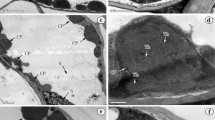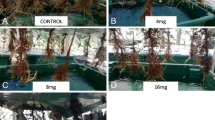Abstract
Seedlings of Iris lactea var. chinensis (Fisch.) Koidz. and I. tectorum Maxim. were subjected to 0–160 mg l−1 Cd in hydroponic system and harvested after 42 days to determine effects on root and shoot dry mass. A subset of 16-day-old seedlings was exposed to 1000 mg l−1 Cd to characterize sub-cellular localization of Cd in root cells. The Cd contents in the shoots of I. lactea var. chinensis reached 529 μg g−1 dry weight (dw) at 80 mg l−1 Cd treatment and in the shoots of I. tectorum reached 232 μg g−1 dw at 40 mg l−1 Cd treatment, without showing signs of visible toxicity. The Cd contents in the shoots of both two test species exceeded 100 μg g−1, the critical value of Cd hyperaccumulator. The indices of tolerance (ITs) of I. lactea var. chinensis were higher than those of I. tectorum under 10–160 mg l−1Cd stress. Sub-cellular localization of Cd in root cells was evaluated using transmission electron microscopy (TEM) and Cd deposits were found in the cell walls, in the cytoplasm and on the inner surface of xylem vessels in the root tip of I. lactea var. chinensis and I. tectorum. A few cells in the root tip of I. tectorum were necrotic. The results showed that the tolerance and accumulation of Cd by I. lactea var. chinensis were higher than those of I. tectorum, suggesting that I. lactea var. chinensis has potential application in phytoremediation.




Similar content being viewed by others
References
Angelova V, Ivanov K, Ivanov R (2004) Effect of Chemical forms of lead, cadmium, and zinc in polluted soil on their uptake by tobacco. J Plant Nutr 27:757–773
Baker AJM, Brooks RR, Pease AJ (1983) Studies on copper and cobalt tolerance in three close related taxa within the genus Silene L. from Zaire. Plant Soil 73:377–385
Baker AJM, McGrath SP, Reeves RD, Smith JAC (2000) Metal hyperaccumulator plants: a review of the ecology and physiology of a biological resource for phytoremediation of metal-polluted soils. In: Terry N, Banuelos Q (eds) Phytoremediation of contaminated soil and water. Lewis Publishers, Boca Raton, Florida, pp 85–197
Belimov AA, Safronova VI, Tsyganov VE, Borisov AY, Kozhemyakov AP, Stepanok VV, Martenson AM, Gianinazzi-Pearson V, Tikhonovich IA (2003) Genetic variability in tolerance to cadmium and accumulation of heavy metals in pea (Pisum sativum L.) Euphytica 131(1):25–35
Białońska D, Zobel AM, Kuraś M, Tykarska T, Sawicka-Kapusta K (2006) Phenolic Compounds and Cell Structure in Bilberry Leaves Affected by Emissions from a Zn-Pb Smelter. Water Air Soil Pollut (available online)
Ernst WHO (1998) Effects of heavy metals in plants at cellular and organismic level. In: Schuurmann G, Markert B (eds) Ecotoxicology. Wiley, New York, pp 587–620
Günther K, Ji G, Kastenholz B (2000) Characterization of high molecular weight cadmium species in contaminated vegetable food. Fresenius J Anal Chem 368:281–287
Heumann HG (2002) Ultrastructural localization of zinc in zinc-tolerant Armeria maritime ssp. halleri by autometallography. J Plant Physiol 159:191–203
Hoagland DR, Arnon DI (1950) The water-culture method for growing plants without soil. California Agricultural Experimental Station Circular 347:1–32
Huang SZ, Han YL, Xie MY (2003) The studies and exploitation of Chinese ornamental Iris resources. Chin Wild Plant Res 22:4–7 (in Chinese)
Jarvis MD, Leung DWM (2001) Chelated lead transport in Chamaecytisus proliferus (L.f) link ssp Proliferus var palmensis (H Christ): an ultrastructural study. Plant Sci 161:433–441
Jiang WS, Liu DH, Hou WQ (2001) Hyperaccumulation of cadmium by roots, bulbs and shoots of garlic (Allium saltivum L.). Bioresour Technol 76:9–13
Khan DH, Duckett JG, Frankland B, Kirkham JB (1984) An X-ray microanalytical study of the distribution of cadmium in roots of Zea Mays L. J Plant Physiol 115:19–28
Liu W, Shu WS, Lan CY (2003) Viola baoshanensis—a new Cd hyperaccumulator. Chin Sci Bull 48:2046–2049
Marchiol L, Sacco P, Assolari S, Zerbi G (2004) Reclamation of polluted soil: phytoremediation potential of crop-related Brassica species. Water Air Soil Pollut 158:345–356
McGrath SP, Zhao FJ, Lombi E (2002) Phytoremediation of metals, metaloids, and adionuclides. Adv Agron 75:1–56
Niagu JO (1988) A silent epidemic of environmental metal poisoning? Environ Pollut 50:139–161
Odjegba VJ, Fasidi IO (2004) Accumulation of trace elements by Pistia stratiotes: implications for phytoremediation. Ecotoxicology 13:637–646
Piechalak A, Tomaszewaska B, Baralkiewisz D (2002) Accumulation and detoxification of lead ion in legumes. Phytochemistry 60:153–162
Rauser WE, Ackerley CA (1987) Location of cadmium in granules within differentiating and mature root cells. Can J Bot 65:643–646
Roy S, Labelle S, Mahta P, Mihoc A, Fortin N, Masson C, Leblanc R, Chateauneuf G, Sura C, Gallipeau C, Olsen C, Delisle S, Labrecque M, Greer CW (2005) Phytoremediation of heavy metal and PAH-contaminated brownfield sites. Plant soil 272:277–290
Salt DE, Prince RC, Pickering IJ, Raskin I (1995) Mechanisms of cadmium mobility and accumulation in Indian mustard. Plant Physiol 109:1427–1433
Salt DE, Smith RD, Raskin I (1998) Phytoremediation. Annu Rev Plant Physiol Plant Mol Biol 49:643–668
SAS Institute Inc. (1994) SAS/STAT User’s Guide, Version 6, 4th edn. 4th Printing, June
Sridhar BBM, Diehl SV, Han FX, Monts DL, Su Y (2005) Anatomical changes due to uptake and accumulation of Zn and Cd in Indian mustard (Brassica juncea). Environ Exp Bot 54:131–141
Su DC, Wong JW (2002) The phytoremediation potential of oilseed rape (B. juncea) as a hyperaccumulator for cadmium contaminated soil. China Environ Sci 22:48–51 (in Chinese)
Sun SC, Wang HX, Li QR (1985) Preliminary Studies on physiological changes and injury mechanism in aquatic vascular plants treated with cadmium. Acta Phytophysiol Sinica 11:113–121
Tong YP, Kneer R, Zhu YG (2004) Vacuolar compartmentalization: a second generation approach to engineering plants for phytoremediation. Trends Plant Sci 9:7–9
Vazquez MD, Barcelo J, Poschenrieder CH, Madico J, Hatton P, Baker AJM Cope GH (1992) Locolization of zinc and cadmium in Thlaspi caerulescens (Brassicaceae), a metallophyte that can hyperaccumulate both metals. J Plant Physiol 140:350–355
Wei SH, Zhou QX, Wang X (2005) Cadmium-hyperaccumulator Solanum nigrum L. and its accumulating characteristics. Environ Sci 26:167–171
Wilkins DA (1957) A technique for the measurement of lead tolerance in plants. Nature 180:37–38
Xiong YH, Yang XE, Ye ZQ, He B (2004) Comparing the characteristics of growth response and accumulation of cadmium and lead by Sedum alfredii Hance. J Northwest Sci-Tech Univ Agric For (Nat Sci Ed) 32:101–106 (in Chinese)
Yu X-Z, Gu J-D (2006) Accumulation and distribution of trivalent chromium and effects on metabolism of the hybrid willow Salix matsudana Koidz × alba L. Arch Environ Contam Toxicol 52:503–511
Yu X-Z, Gu J-D (2007) Hexavalent chromium induced stress and metabolic responses in hybrid willows. Ecotoxicology 16:299–309
Acknowledgments
Project financially supported by the Natural Science Foundation of China (No. 30270940) and the Project of Advanced Agricultural Technique of Jiangsu Province, China (No. BE2003303)
Author information
Authors and Affiliations
Corresponding author
Rights and permissions
About this article
Cite this article
Han, YL., Yuan, HY., Huang, SZ. et al. Cadmium tolerance and accumulation by two species of Iris . Ecotoxicology 16, 557–563 (2007). https://doi.org/10.1007/s10646-007-0162-0
Received:
Accepted:
Published:
Issue Date:
DOI: https://doi.org/10.1007/s10646-007-0162-0




